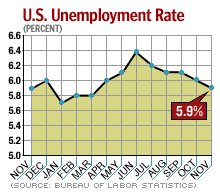NEW YORK (CNN/Money) -
Jobless claims fell in the United States last week, the government said Thursday, coming in below Wall Street forecasts and offering a number of encouraging signs about the labor market.
But some economists cautioned that the recovery may continue to be painfully slow and called for another extension of a federal unemployment benefits program due to expire this month.

The Labor Department said 353,000 people filed new claims for state unemployment benefits in the week ended Dec. 13, versus a revised reading of 375,000 the prior week. Economists, on average, expected 365,000 new claims, according to Briefing.com.
The four-week moving average of new claims, which irons out the volatility of the weekly data, fell to 361,750 from a revised 364,000 the prior week.
And continued claims, the number of people out of work for a week or more, rose to 3.39 million for the week ended Dec. 6, the latest data available, from a revised 3.33 million the prior week.
"We're finally getting consistently good news on the labor markets and even an occasional positive surprise like today's report," said Oscar Gonzalez, economist at John Hancock Financial Services in Boston.
On Wall Street, stocks rallied on the news while Treasury bond prices pulled back.
Surprisingly, the number of claims in the Dec. 6 week was revised downward after the department got new data from the states -- the first such downward revision in 92 weeks, according to Tony Crescenzi, chief bond market strategist at Miller Tabak & Co., and possibly a hopeful sign for the labor market.
"It suggests the trend has changed, because each week's estimate is based on the trends," Crescenzi said. "This is clearly an important change, when taken with other news, particularly monthly payroll statistics. It suggests more good news is on the way."
The report was rife with good news, in fact:
- The number of jobless claims was the lowest since the Nov. 1 week
- Jobless claims have remained below 400,000 -- a level most economists consider to be an indicator of an improving job market -- for 11 straight weeks, the best streak since April 2001
- The four-week moving average of the number of people drawing benefits for more than one week shrank to 3.33 million, the lowest since the fall of 2001
And payrolls outside the farm sector have grown, though slightly, the past four months, while the unemployment rate has dropped to 5.9 percent from its June peak of 6.4 percent.
Most economists say they're hoping that the labor market will continue to gather steam next year.
"Clearly, the labor market is improving, and this should translate into more jobs in the future," said Sung Won Sohn, chief economist at Wells Fargo & Co.
Economists call for benefit extension
Still, the job market has quite a ways to go before it can be declared fully healed.
| Related stories
|

|
|
|
|
Twenty-four months after the latest recession's "official" end in November 2001, as defined by the National Bureau of Economic Research, all the jobs lost in the United States still have not been recovered -- the longest such slump since World War II.
"We all remember the 'jobless recovery' of the 1990s -- that experience was, for the labor market, significantly worse than [any in post-World War II] history, " Princeton economics professor Alan Blinder, a former Federal Reserve Vice Chairman, said in a conference call with reporters.
"The current episode is vastly worse than that; there's only been the slightest bit of a paltry recovery in the labor market."
Blinder, along with Harvard professor Lawrence Katz and economist Isaac Shapiro of the Center on Budget & Policy Priorities, a left-leaning think tank in Washington, called for President Bush and Congress to extend federal jobless benefits for unemployed people whose state benefits have expired.
The program, which has helped about 300,000 people every month since its inception in early 2002, is set to expire on Dec. 27, and Congress did not raise the possibility of an extension in its latest session.
Some economists and politicians say the economy, which grew at a blistering 8.2 percent rate in the third quarter, is strong enough that more jobs will be available soon, meaning the benefits program can expire.
But Blinder, Katz and Shapiro noted that several job-market stats are worse now than they were when the temporary program was initiated. The unemployment rate and number of people out of work for 27 weeks or more are higher, while the number of available jobs, as measured by the Labor Department, is lower.
"There are three unemployed workers for every job opening out there," Katz said, "which shows you how difficult it is, if you exhaust your unemployment benefits, to find a job in today's economy."

|

